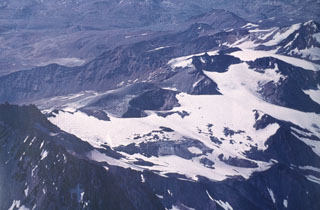Report on Planchon-Peteroa (Chile) — 8 September-14 September 2010
Smithsonian Institution / US Geological Survey
Weekly Volcanic Activity Report, 8 September-14 September 2010
Managing Editor: Sally Sennert.
Please cite this report as:
Global Volcanism Program, 2010. Report on Planchon-Peteroa (Chile) (Sennert, S, ed.). Weekly Volcanic Activity Report, 8 September-14 September 2010. Smithsonian Institution and US Geological Survey.
Planchon-Peteroa
Chile
35.223°S, 70.568°W; summit elev. 3977 m
All times are local (unless otherwise noted)
SERNAGEOMIN reported that an overflight of Planchón-Peteroa on 7 September revealed that the explosions the day before were possibly phreato-magmatic in origin and similar to the explosions in 1991. Pulses of gas and ash had occurred every 40-60 seconds during the eruption. Plumes rose 200 m above the crater and ash mostly fell within 10 km to the E. During 10-13 September, plumes rising from the vent had progressively less ash and higher concentrations of water vapor. On 13 September, SERNAGEOMIN reported that petrographic and mineralogical studies of the ash indicated no juvenile components. The Alert Level remained at 4, Yellow.
Geological Summary. Planchón-Peteroa is an elongated complex volcano along the Chile-Argentina border with several overlapping calderas. Activity began in the Pleistocene with construction of the basaltic-andesite to dacitic Volcán Azufre, followed by formation of basaltic and basaltic-andesite Volcán Planchón, 6 km to the north. About 11,500 years ago, much of Azufre and part of Planchón collapsed, forming the massive Río Teno debris avalanche, which traveled 95 km to reach Chile's Central Valley. Subsequently, Volcán Planchón II was formed. The youngest volcano, andesitic and basaltic-andesite Volcán Peteroa, consists of scattered vents between Azufre and Planchón. Peteroa has been active into historical time and contains a small steaming crater lake. Historical eruptions from the complex have been dominantly explosive, although lava flows were erupted in 1837 and 1937.
Source: Servicio Nacional de Geología y Minería (SERNAGEOMIN)

